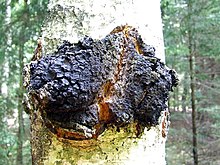Inonotus obliquus
| Inonotus obliquus | |
|---|---|

| |
| Scientific classification | |
| Domain: | Eukaryota |
| Kingdom: | Fungi |
| Division: | Basidiomycota |
| Class: | Agaricomycetes |
| Order: | Hymenochaetales |
| Family: | Hymenochaetaceae |
| Genus: | Inonotus |
| Species: | I. obliquus
|
| Binomial name | |
| Inonotus obliquus (
Pers. ) Pilát (1942) | |
| Synonyms[1] | |
|
Boletus obliquus Ach. ex Pers. (1801) | |
| Inonotus Obliquus parasitic | |
|---|---|
| Edibility is choice | |

Inonotus obliquus, commonly called chaga (
Common names
The name chaga comes from the
Morphology
Inonotus obliquus causes a white
Chemistry
The black sclerotium has large concentrations of melanin.[8][9] Chaga contains extremely high concentrations of oxalate, 2800–11200 mg total oxalates/100 g sclerotium, one of the highest reported in any organism.[10]
Distribution and habitat
Inonotus obliquus is found most commonly in the Circumboreal Region of the Northern Hemisphere, where it is distributed in birch forests.[6]
Generally found growing on birch (
Cultivation
Attempts at cultivating this fungus on potato dextrose agar and other simulated media resulted in a reduced and markedly different production of metabolites.[12][13] Cultivated chaga developed a reduced number of phytosterols, particularly lanosterol, an intermediate in the synthesis of ergosterol and lanostane-type triterpenes.[12]
Uses
Chaga is traditionally grated into a fine powder and used to brew a beverage resembling
- Hot water extraction is certainly the most common preparation. A decoction is created by simmering blocklike pieces of the chaga in numerous quarts of water until the water is reduced and the remaining liquid contains a portion of the chaga's concentrated water-soluble compounds. Such preparations, produced in China and Japan, are exported worldwide. The β-D-glucans may have a content of approximately 35% in a pure extract.[15] If chaga tea is prepared at home, the chaga chunks can be reused multiple times.
See also
- Herbalism
- Medicinal fungi
- Polypores
References
- ^ "Inonotus obliquus (Ach. ex Pers.) Pilát 1942". MycoBank. International Mycological Association. Retrieved 11 October 2011.
- S2CID 46047121.
- ISBN 978-1-4930-2669-2.
- ^ Needham, Arthur (16 December 2005). "Clinker Polypore, Chaga". Archived from the original on 9 September 2011. Retrieved 10 October 2011.
- ^ "Sterile conk trunk rot of birch". Canadian Forest Service, Natural Resources Canada, Government of Canada. 4 August 2015. Retrieved 15 August 2017.
- ^ PMID 23997626.
- ^ MushroomExpert.Com. "Inonotus obliquus (MushroomExpert.Com)". mushroomexpert.com. Retrieved 15 August 2017.
- ^ Babitskaya, VG; Shcherba, VV; Lkonnikova, NV; Bisko, NA; Mitropolskaya, NY (2002). "Melanin complex from medicinal mushroom Inonotus obliquus (Pers: Fr) Pilát (chaga) (Aphyllophoromyceditdeae)". Int J Med Mushrooms. 4: 139–145.
- S2CID 23095628.
- PMID 23149251.
- ^ Ryvarden L, Gilbertson RL (1993). European polypores. Part 1. Oslo: Fungiflora-Fungiflora. pp. 1–387.
- ^ PMID 17882960.
- S2CID 22145043.
- PMID 32419395.
- .
